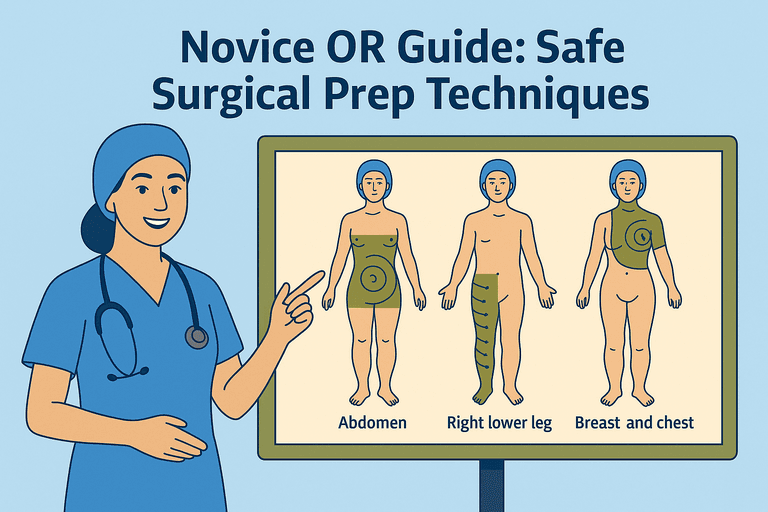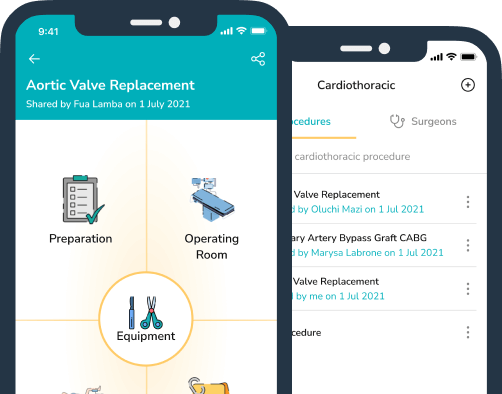Reducing SSIs Through Best Practice Skin Preparation: What Every OR Nurse Should Know
Posted at 11 June 2025 in Clinical Best Practices,Education,Education & Training,Infection Prevention,Operating Room,Operating Room Education,OR Nursing,Perioperative Education,Skin Antisepsis,Surgical Nursing by Marrianne
Best Practice for Surgical Skin Preparation: Reducing the Risk of Surgical Site Infections (SSIs)
Surgical skin preparation is one of the most critical steps in preventing Surgical Site Infections (SSIs)—a complication that not only affects patient recovery but places a significant financial burden on healthcare systems worldwide.
🦠 Why Surgical Site Infections Matter
SSIs are among the most common types of healthcare-associated infections and can occur in up to 5% of surgical procedures. Their consequences extend beyond the immediate surgical outcome:
-
In Australia, SSIs add an average $18,814 to the direct cost of treatment per patient.
-
In the United States, SSIs cost the healthcare system $3.3 to $10 billion annually.
-
A single infection following a hip or knee replacement can add $12,689 USD in direct costs.
-
SSIs significantly prolong hospital stays, often requiring readmission, further tests, and additional treatment.
Given the clinical and economic impact, preventing SSIs is not only a patient safety priority—it’s a healthcare imperative.
🧼 What Is Surgical Skin Preparation?
Surgical skin preparation involves cleansing the skin at and around the surgical site to reduce the microbial count to the lowest possible level. The goal is to create a sterile field that minimizes the risk of microbial contamination during the procedure.
Key Principles of Best Practice:
-
Clean to Dirty: Begin at the cleanest area—typically the planned incision site—and work outward in concentric circles or squares.
-
No Double Dipping: Use a fresh swab for each pass. Never return a used applicator to the antiseptic solution.
-
Wide Coverage: Prep a generous area to accommodate any extension of the surgical incision.
-
High-Risk Zones Prepped Last: Areas such as the groin, umbilicus, open wounds, stomas, orifices should be cleaned last and with separate sponges.
-
Reverse Technique for Contaminated Areas: For high-risk zones, start at the cleaner periphery and move inward to the more contaminated center.
The AORN (Association of periOperative Registered Nurses) recommends selecting an alcohol-based prepping agent based on the anatomical location and patient assessment. Alcohol-based preps should not be used near mucosa, eyes, or ears. Iodine-based alternatives are safer in such cases.
📊 Why It’s Done This Way – The Evidence Behind the Method
The technique of prepping from clean to dirty and using separate applicators for contaminated zones is designed to:
-
Prevent cross-contamination within the sterile field.
-
Maintain the lowest possible bacterial load at the incision site.
-
Ensure compliance with infection control standards such as those outlined by AORN, ACORN, and WHO guidelines.
👩⚕️ Educating the Next Generation of Perioperative Professionals
Understanding why and how we perform surgical skin preparation is critical for novice operating room staff. Proper technique supports not only patient safety, but also team trust, procedure efficiency, and hospital sustainability.
Visual guides help reinforce learning by showing the correct prepping zones and motion patterns for various surgical sites.
📷 
✅ Final Thoughts
Following best practice in surgical skin preparation isn’t just a procedural checklist item—it’s a frontline defense against infection. When done correctly, it protects patients, reduces complications, and ensures that the operating team upholds the highest standards of care.
Stay vigilant, prep with purpose, and lead with best practice.
Recent Articles
Electrosurgery & Cautery Safety: Protecting Patients Through Vigilance, Communication, and Best Practice
09 December 2025
✈️From Pilots to Perioperative Practice: Why Organisation and Readiness Save Lives in the OR
28 October 2025
Categories
More articles from Clinical Best Practices,Education,Education & Training,Infection Prevention,Operating Room,Operating Room Education,OR Nursing,Perioperative Education,Skin Antisepsis,Surgical Nursing
View AllElectrosurgery & Cautery Safety: Protecting Patients Through Vigilance, Communication, and Best Practice
⭐ A Personal Note on Perioperative Practice Every day in the operating room, perioperative professionals carry a...
09 December 2025
Read more✈️From Pilots to Perioperative Practice: Why Organisation and Readiness Save Lives in the OR
Instrument nurses anticipate, troubleshoot, and act quickly under the direction of the surgeon and surgical team. T...
28 October 2025
Read more🌟 Building Competence in the OR Takes Time—And Pays Off
Instrument and circulator nurses and technologists perform some of the most complex, high-pressure roles in healthc...
27 October 2025
Read more

